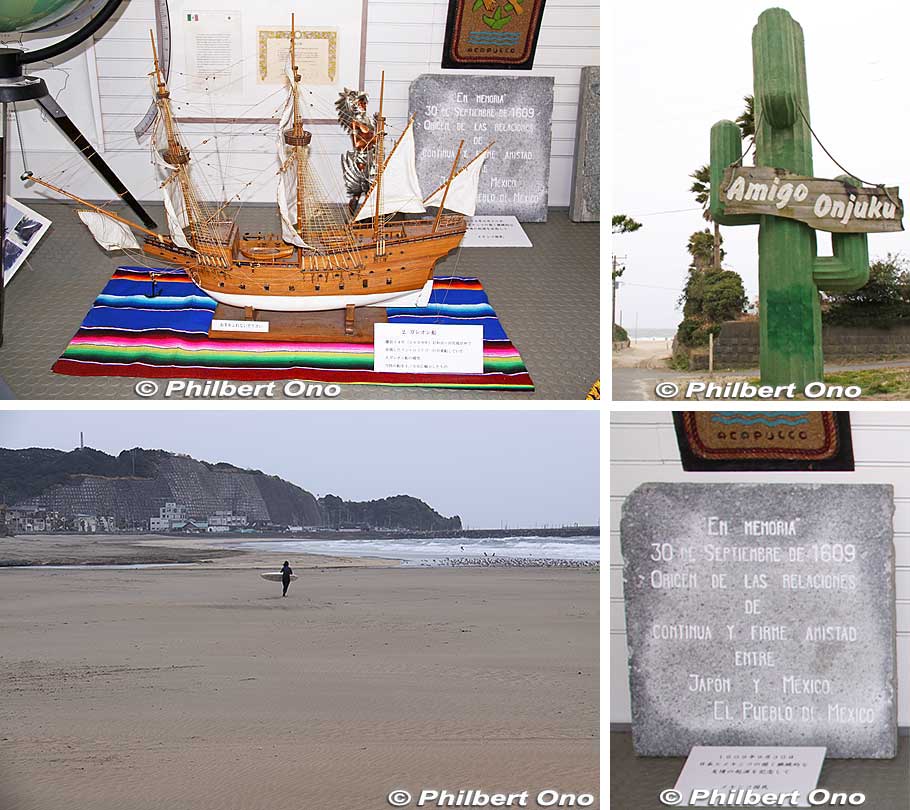
Onjuku is a coastal town with white sand beaches facing the Pacific Ocean. In normal summers, it gets crowded with beachgoers. Upper right photo shows one entrance to the beach. It’s also home of ama women divers who have been diving for shellfish here since centuries ago. After the geisha girl, ama women divers are perhaps the most intriguing and interesting Japanese women to foreigners.
Up until the 1960s, Onjuku attracted many Japanese male photographers (mostly pervs) who came to pay the ama women divers to pose topless on the beach and in the water. (They normally did not dive topless.) It was a time when nudity in Japan was still considered to be a natural thing and not really sinful or shameful.
Next to Onjuku Beach is the Onjuku Museum of History and Folklore (御宿歴史民俗資料館) that includes a few photos of the ama divers taken by local photograher and photo shoot organizer Iwase Yoshiyuki (1904-2001). The museum also prominently featured a very interesting and heartwarming friendship story about Japan and Spain (Mexico) going back to the 17th century. A story that is still proudly remembered today in Onjuku and Chiba Prefecture.
The museum has exhibits about this historical incident including a scale model (upper left photo) of a Spanish (Mexican) galleon named “San Francisco” (after the saint, not the city where I left my heart). Mexico was part of Spain at the time.
The story goes like this: On the morning of Sept. 30, 1609, Mexican galleon San Francisco sailing the trade route from Manila to Acapulco got caught in a typhoon and was shipwrecked off Iwawada (岩和田), Onjuku Beach in Chiba Prefecture. There were 373 on board, and local villagers in Iwawada rescued the crew. The sailors were suffering from the cold, so the young ama women divers used their bare bodies to warm them up. Thanks to such efforts, 317 of the crew survived and only 56 died.
The local samurai lord Honda Tadatomo (本多忠朝) had the surviving crew well taken care of in Iwawada for 37 days. They were then sent to Uraga Port (Kanagawa) where they left Japan for Mexico.
The story doesn’t end there though. A major offshoot saga began with Rodrigo de Vivero, called “Don Rodrigo” in Japan, who also survived the shipwreck. Rodrigo had just finished his term as Governor General of the Philippines, then a Spanish colony. He was on the shipwrecked San Francisco while on his way home to Acapulco. He ended up staying in Japan for 10 months.
He met with Shogun Tokugawa Hidetada at Edo Castle (Tokyo) and also Hidetada’s father, former shogun Tokugawa Ieyasu retired at Sunpu Castle in Shizuoka. Ieyasu wanted to start trade relations with Spain and New Spain (Mexico) and believed that Rodrigo could help with this. In Aug. 1610, Ieyasu allowed Rodrigo to sail home to Acapulco on the Japanese galleon “San Buena Ventura” built in Japan by the shogun’s British advisor William Adams (aka Miura Anjin, depicted as Blackthorne in the mini TV series and novel “Shogun” by James Clavell).
Rodrigo sailed home to Mexico with 22 Japanese samurai. The Japanese wore their samurai attire and swords in Mexico. Several of the Japanese even got baptized and received Christian names. Three of the samurai chose to remain in Mexico. The rest returned to Japan after two months. A trade treaty was eventually established between the two countries. However, trade with Spain/Mexico was later suspended in 1624 when the shogun tried to stamp out Christianity. Spanish galleons were no longer allowed into Japan.
In 1928, a 17-meter-high memorial obelisk to mark the shipwreck rescue and friendly relations between Japan and Mexico was built in Onjuku with donations from Mexico, Spain, and other countries. It’s still there, now complemented with a sculpture of an ama woman diver wrapping her body around a Spanish sailor. In the lower left photo, this obelisk can be seen on the hill toward the left.
During World War II, the Japanese Army ordered the obelisk to be removed out of fear that it could be used as a target for enemy navy ships. Local residents opposed this and painted it black to make it less noticeable. However, it did suffer some aerial machine gun fire that damaged the marble. In 1958, the damage was repaired with concrete funded by donations from Mexico, Spain, and Onjuku.
In 1978, Onjuku and Acapulco established sister-city relations. And in 2013, Onjuku established a sister-city relationship with Tecamachalco, Puebla, Mexico, the birthplace of Don Rodrigo. Another example of how good things that go around also come around, even centuries later. ![]()
![]() Onjuku Beach and Onjuku Museum of History and Folklore are near JR Onjuku Station on the JR Sotobo Line. Free admission. Open 9 am to 5 pm. Closed Mon.
Onjuku Beach and Onjuku Museum of History and Folklore are near JR Onjuku Station on the JR Sotobo Line. Free admission. Open 9 am to 5 pm. Closed Mon.
Museum site: http://www.town.onjuku.chiba.jp/sub6/7/minzoku_shiryoukan_01/
The obelisk (Mexico Memorial) (日西墨三国交通発祥記念之碑) is here: https://goo.gl/maps/qGEzERgJx8bfoNzY6
There’s also a marker at the location where the shipwrecked sailors landed, now named the Don Rodrigo Landing Point (ドン・ロドリゴ上陸の地): https://goo.gl/maps/rond5jkZdWh8taE37